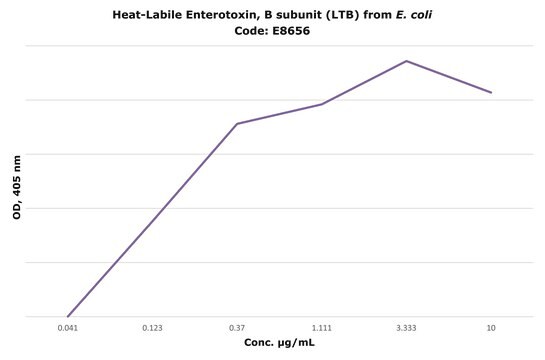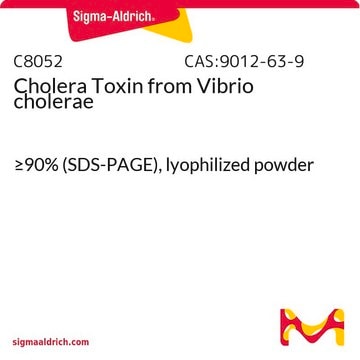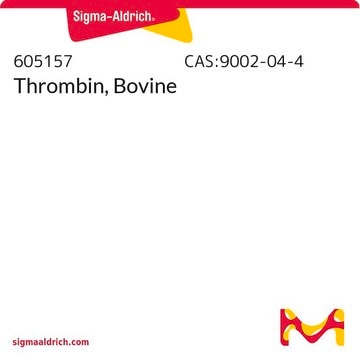Alle Fotos(1)
Wichtige Dokumente
E5763
Escherichia coli heat-stable enterotoxin STa
lyophilized powder, ~100,000 units/mg protein (HPLC)
Anmeldenzur Ansicht organisationsspezifischer und vertraglich vereinbarter Preise
Alle Fotos(1)
About This Item
MDL-Nummer:
UNSPSC-Code:
12352200
Empfohlene Produkte
Form
lyophilized powder
Spezifische Aktivität
~100,000 units/mg protein (HPLC)
Mol-Gew.
1,972 Da
Löslichkeit
aqueous buffer: ≥5 mg/mL (More soluble under acidic conditions)
Lagertemp.
−20°C
Biochem./physiol. Wirkung
STa has a tertiary structure, maintained by disulfide bridges, which is required for receptor binding and biological activity. Its receptors are membrane-bound guanylyl cyclases. These receptors are located on enterocytes, colonocytes, and various extraintestinal tissues. STa causes diarrhea in humans by binding to its receptor, stimulating the guanylyl cyclase, and triggering production of cyclic GMP. Endogenous ligands for the STa receptor include guanylin, extracted from intestine, and uroguanylin from urine. These peptides may have a role in the regulation of fluid and electrolytes. Protein kinase C (PKC) phosphorylates and activates the STa receptor/guanylyl cyclase in vitro and in vivo. As a result, stimulators of PKC synergistically enhance STa effects on cGMP and secretion.
Sonstige Hinweise
E. coli STa is a heat-stable peptide toxin.
Einheitendefinition
One unit is the amount of toxin which produces an intestinal weight/carcass weight ratio of ≥0.083 in 3-day-old mice.
Lagerklassenschlüssel
6.1A - Combustible acute toxic Cat. 1 and 2 / very toxic hazardous materials
WGK
WGK 3
Flammpunkt (°F)
Not applicable
Flammpunkt (°C)
Not applicable
Hier finden Sie alle aktuellen Versionen:
Besitzen Sie dieses Produkt bereits?
In der Dokumentenbibliothek finden Sie die Dokumentation zu den Produkten, die Sie kürzlich erworben haben.
R N Greenberg et al.
Journal of investigative medicine : the official publication of the American Federation for Clinical Research, 45(5), 276-282 (1997-06-01)
Uroguanylin and guanylin are intestinal peptides that activate a receptor-guanylate cyclase, which is also a receptor for Escherichia coli heat-stable enterotoxin (STa). These peptides may have a role in the body's regulation of fluid and electrolytes. STa, bioactive guanylin, and
J K Crane et al.
Molecular and cellular biochemistry, 165(2), 111-120 (1996-12-20)
The heat-stable enterotoxin STa of E. coli causes diarrhea by binding to and stimulating intestinal membrane-bound guanylyl cyclase, triggering production of cyclic GMP. Agents which stimulate protein kinase C (PKC), including phorbol esters, synergistically enhance STa effects on cGMP and
R A Giannella
The Journal of laboratory and clinical medicine, 125(2), 173-181 (1995-02-01)
STa represents a family of homologous heat-stable peptide toxins that are elaborated by a variety of bacteria capable of causing enteric disease in human beings. All these peptides have a tertiary structure, maintained by disulfide bridges, which is required for
S P Range et al.
British journal of pharmacology, 120(7), 1249-1254 (1997-04-01)
1. Guanosine 3':5'-cyclic monophosphate (cyclic GMP) is an important second messenger mediating the effects of nitric oxide (NO) and natriuretic peptides. Cyclic GMP pathways regulate several aspects of lung pathophysiology in a number of airway cells. The regulation of this
A M Al-Majali et al.
Journal of immunological methods, 222(1-2), 65-72 (1999-02-18)
Binding of Escherichia coli heat-stable enterotoxin (STa) to its putative receptor on the brush border membrane of enterocytes is a prerequisite for the induction of diarrhea in infected humans and animals. Humans and animals of different ages vary in their
Unser Team von Wissenschaftlern verfügt über Erfahrung in allen Forschungsbereichen einschließlich Life Science, Materialwissenschaften, chemischer Synthese, Chromatographie, Analytik und vielen mehr..
Setzen Sie sich mit dem technischen Dienst in Verbindung.








